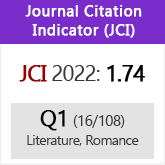Cervantes: Statue in Madrid, Monument of the Nation
DOI:
https://doi.org/10.3989/anacervantinos.2014.014Keywords:
Monumentalization, Cultural Symbols, Cervantes, Statue in 1835, Spanish Democracy, National Unity, Lettered CirclesAbstract
This paper revisits the erection of a statue of Cervantes in Madrid, 1835. Drawing on Rachel Schmidt and Joaquín Álvarez Barrientos, I link this statue to the cultural and political process of symbolic monumentalization of Cervantes. This process originated in late Spanish Enlightenment, followed up by Godoy’s government and the “afrancesados”. After the Ominous Decade, during the final crisis of Ferdinand VII and the first “democratic” governments under María Cristina’s regency, Cervantes would became a cultural symbol of national unity.
Downloads
References
Álvarez Barrientos, Joaquín (2009). Miguel de Cervantes Saavedra: “monumento nacional”. Madrid: CSIC.
Assmann, Jan (2008). «Communicative and Cultural Memory», en Astrid Erll y Ansgar Nünning (ed.), A Companion to Cultural Memory Studies. An International and Interdisciplinary Handbook. Berlin-New York: Walter de Gruyter, pp. 109-118.
Benjamin, Walter (2002). The Arcades Project, Rolf Tiedemann (ed.), Howard Eiland y Kevin McLaughlin (trad.). Cambridge: Belknap Press of Harvard.
Burton, A.P. (1968). «Cervantes the man seen through English eyes in the seventeenth and eighteenth centuries», Bulletin of Hispanic Studies. 45, pp. 1-15.
Byers, A. Martin (1992). «The Action-Constitutive Theory of Monuments: A Strong Pragmatist Version», Journal for the the Theory of Social Behaviour. 22.4, pp. 401-46.
Cabarrús, Francisco de (1808). Cartas sobre los obstáculos que la naturaleza, la opinión y las leyes oponen a la felicidad pública. Vitoria: Imprenta de Pedro Real.
Cadalso, José de (2000). Cartas marruecas. Noches lúgubres, Emilio Martínez Mata (ed.). Barcelona: Crítica.
Capmany, Antonio de (1788). Teatro histórico-crítico de la elocuencia española. Madrid: Antonio de Sancha, vol. 4.
Cherchi, Paolo (1977). Capitoli di critica cervantina (1605-1789). Roma: Bulzoni.
Choay, Françoise (1992). L’Allégorie du patrimoine. Paris: Seuil.
Connerton, Paul (1989). How societies remember. Cambridge: Cambridge University Press.
Crane, Susan A. (1997). «Writing the Individual Back into Collective Memory», The American Historical Review. 102.5, pp. 1372-1385.
Cuevas Cervera, Francisco (2012). El cervantismo en el siglo XIX: catálogo comentado y estudio. Cádiz: Universidad, tesis doctoral.
Fernández de los Ríos, Ángel (1876). Guía de Madrid. Manual del madrileño y del forastero. Madrid: Oficina de la Ilustración Europea y Americana.
Fernández de Moratín, Nicolás y Leandro (2008). Los Moratines. Obras completas, Jesús Pérez-Magallón (ed.). Madrid, Cátedra, vol. 1.
González, Enric (2012). «Josep Fontana y Enric González o qué ocurre en Cataluña», Jot Down. Contemporary culture mag. Accesible en: < http://www.jotdown.es/2012/11/ josep-fontana-y-enric-gonzalez-o-que-ocurre-en-cataluna/> (27.11.2014).
Halbwachs, Maurice (1950). La mémoire collective. Accesible en: <http://classiques.uqac.ca/classiques/Halbwachs_maurice/memoire_collective/memoire_collective.html> (27.11.2014).
Martínez Mata, Emilio (2005). «El Quijote, sátira antiespañola», Voz y Letra. 16.1-2, pp. 95-104.
Mercader Riba, Juan (1983). José Bonaparte, rey de España 1808-1813. Estructura del estado español bonapartista. Madrid: CSIC.
Mesonero Romanos, Ramón de (2000). El antiguo Madrid. Madrid: Trigo Ediciones.
Neiger, Motti, Meyeres, Oren y Zandberg, Eyal (2011). On Media Memory. Collective Memory in a New Media Age. London: Palgrave McMillan.
Nelson, Robert N. y Olin, Margaret (2003). Monuments and Memory, Made and Unmade. Chicago: University of Chicago Press.
Nora, Pierre (1989). «Between Memory and History: Le Lieux de Mémoire», Representations. 26, pp. 7-24.
Pérez-Magallón, Jesús (2010). Calderón, icono cultural e identitario del conservadurismo político. Madrid: Cátedra.
Reyero, Carlos (2003). «Monumentalizar la capital: la escultura conmemorativa en Madrid durante el siglo XIX», en María del Carmen Lacarra Ducay y Cristina Giménez Navarro (ed.), Historia y política a través de la escultura pública, 1820-1920. Zaragoza: Institución Fernando el Católico, pp. 41-62.
Rico, Francisco (2005). Quijotismos. Aldeamayor de San Martín: Ayuntamiento de Aldeamayor de San Martín. Accesible en: <http://www.cervantesvirtual.com/obra quijotismos--0/> (27.11.2014).
Rincón Lezcano, José (1909). Historia de los monumentos de la Villa de Madrid. Madrid: Imprenta Municipal.
Sarmiento, Martín (1898). Noticia de la verdadera patria (Alcalá) de El Miguel de Cervantes. Barcelona: Librería de Álvaro Verdaguer.
Winkler, Hartmut (2002). «Discourses. Schemata, Technology, Monuments: Outline for a Theory of Cultural Continuity», Configurations. 10.1, pp. 91-109.
Young, James E. (1993). The Texture of Memory: Holocaust Memorials and Meaning. New Haven: Yale University Press.
Downloads
Published
How to Cite
Issue
Section
License
Copyright (c) 2014 Consejo Superior de Investigaciones Científicas (CSIC)

This work is licensed under a Creative Commons Attribution 4.0 International License.
© CSIC. Manuscripts published in both the printed and online versions of this Journal are the property of Consejo Superior de Investigaciones Científicas, and quoting this source is a requirement for any partial or full reproduction.All contents of this electronic edition, except where otherwise noted, are distributed under a “Creative Commons Attribution 4.0 International” (CC BY 4.0) License. You may read here the basic information and the legal text of the license. The indication of the CC BY 4.0 License must be expressly stated in this way when necessary.
Self-archiving in repositories, personal webpages or similar, of any version other than the published by the Editor, is not allowed.














